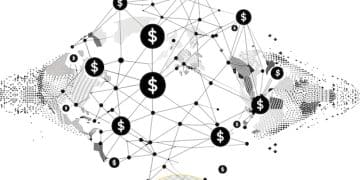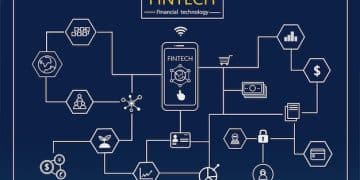DeFi Trends for US Investors: Navigating the Decentralized Finance Landscape

Decentralized Finance (DeFi) is rapidly evolving, presenting both opportunities and challenges for US investors; key emerging trends include regulatory clarity, institutional adoption, enhanced security measures, the integration of Real World Assets (RWAs), and Layer-2 scaling solutions, each carrying significant implications for investment strategies and risk management.
What are the Emerging Trends in Decentralized Finance (DeFi) and Their Implications for US Investors? This question looms large as DeFi continues to reshape the financial landscape. Let’s explore the key innovations and considerations for US investors navigating this dynamic space.
Understanding the Rise of Decentralized Finance (DeFi)
Decentralized Finance, or DeFi, has emerged as a groundbreaking force within the fintech landscape. It aims to recreate traditional financial systems in a decentralized, permissionless, and transparent manner. This section explores the fundamental principles and growth trajectory of DeFi, setting the stage for US investors to grasp its potential impacts.
What is DeFi?
At its core, DeFi seeks to eliminate intermediaries, such as banks, from financial transactions. Instead, it utilizes smart contracts on blockchains to automate and secure processes like lending, borrowing, trading, and investing. This approach offers greater accessibility, efficiency, and control to users.
Rapid Growth and Adoption
The DeFi ecosystem has experienced exponential growth in recent years. Fueled by innovation and a desire for alternative financial solutions, the total value locked (TVL) in DeFi protocols has surged, attracting both retail and institutional interest. This growth highlights the increasing recognition of DeFi’s potential to disrupt legacy financial systems.

Here are some factors contributing to the rise of DeFi:
- Accessibility: DeFi platforms offer financial services to anyone with an internet connection, regardless of geographic location or credit score.
- Transparency: Blockchain technology provides a transparent and immutable record of all transactions, enhancing trust and accountability.
- Efficiency: Automated smart contracts streamline processes and reduce operational costs, leading to faster and cheaper transactions.
In conclusion, the rise of DeFi represents a fundamental shift in the financial industry. By understanding its core principles and growth drivers, US investors can better assess the opportunities and risks associated with this emerging asset class.
Regulatory Scrutiny and the Path to Clarity in the US
One of the most significant emerging trends in DeFi is the increasing regulatory scrutiny, particularly in the United States. The lack of clear regulatory frameworks has created uncertainty for investors and projects alike. This section explores the current state of regulation and potential future developments.
SEC’s Stance on DeFi
The Securities and Exchange Commission (SEC) has taken a cautious approach to DeFi, expressing concerns about investor protection and market manipulation. The SEC’s focus primarily revolves around whether certain DeFi tokens or activities qualify as securities, which would subject them to existing securities laws.
Potential Regulatory Frameworks
Several proposals for regulating DeFi have emerged, ranging from adapting existing regulations to creating new frameworks specifically tailored for decentralized technologies. These proposals aim to strike a balance between fostering innovation and safeguarding investors.
Key considerations for future regulations include:
- Defining Decentralization: Establishing clear criteria for what constitutes a truly decentralized protocol is essential to avoid regulatory arbitrage.
- Investor Protection: Regulations should address issues such as fraud, scams, and rug pulls, which are prevalent in the DeFi space.
- Compliance Costs: Regulatory frameworks must be designed to minimize compliance costs for smaller projects and startups, ensuring that innovation is not stifled.
Ultimately, regulatory clarity is crucial for the long-term growth and adoption of DeFi in the US. A well-defined regulatory landscape will provide a level playing field for all participants and encourage institutional investment, setting the stage for sustainable growth.
Institutional Adoption and Integrating Traditional Finance
Institutional adoption is another major trend reshaping the DeFi landscape. As traditional financial institutions recognize the potential of DeFi, they are exploring ways to integrate it into their existing operations. This integration could lead to increased liquidity, stability, and legitimacy for the DeFi ecosystem.
Growing Interest from Institutions
Hedge funds, asset managers, and even banks are beginning to experiment with DeFi. They are attracted by the potential for higher yields, increased efficiency, and access to new markets. Some institutions are even launching their own DeFi products and services.
Challenges and Opportunities
Integrating DeFi with traditional finance presents several challenges. These include regulatory compliance, security concerns, and the need for robust risk management frameworks. However, the potential benefits are significant, with opportunities for greater efficiency, transparency, and innovation.

Examples of institutional participation in DeFi include:
- Yield Farming: Institutions are deploying capital into DeFi protocols to earn yield on their assets.
- Tokenization of Assets: Traditional assets, such as real estate and commodities, are being tokenized and traded on DeFi platforms.
- DeFi Lending and Borrowing: Institutions are using DeFi protocols to lend and borrow digital assets.
Institutional adoption could be a game-changer for DeFi. By bringing in capital, expertise, and regulatory oversight, institutions can help to mature the DeFi ecosystem and make it more accessible to a wider range of investors.
Enhanced Security Measures and Auditing Protocols
Security remains a paramount concern in the DeFi space. Smart contract vulnerabilities, hacks, and exploits have plagued the ecosystem, resulting in significant financial losses for investors. Addressing these security issues is crucial for building trust and fostering wider adoption.
Smart Contract Audits
Smart contract audits are becoming increasingly important. These audits involve independent security firms reviewing the code of DeFi protocols to identify potential vulnerabilities. While audits are not foolproof, they can significantly reduce the risk of exploits.
Insurance and Risk Mitigation
DeFi insurance protocols are emerging to provide coverage against smart contract failures and other risks. These protocols allow users to purchase insurance policies that will compensate them in the event of a hack or exploit. Risk mitigation strategies are likewise evolving to help protect investors.
Key security measures in DeFi include:
- Formal Verification: Using mathematical techniques to verify the correctness of smart contract code.
- Bug Bounty Programs: Incentivizing developers and security researchers to find and report vulnerabilities.
- Decentralized Governance: Utilizing community governance to make critical decisions and respond to security threats.
Enhanced security measures are essential for the long-term sustainability of DeFi. By prioritizing security and implementing robust safeguards, the DeFi ecosystem can foster greater trust and confidence among investors.
Real World Assets (RWAs) and the Future of Tokenization
The integration of Real World Assets (RWAs) into DeFi is a rapidly growing trend. Tokenizing traditional assets and bringing them on-chain opens up new opportunities for liquidity, efficiency, and accessibility. This section examines the impact of RWAs on the DeFi ecosystem.
What are Real World Assets?
Real World Assets are physical or intangible assets that exist outside the digital realm. Examples include real estate, commodities, art, and intellectual property. By tokenizing these assets, they can be fractionalized, traded, and used as collateral in DeFi protocols.
Benefits of RWA Integration
Integrating RWAs into DeFi offers several benefits. It can increase liquidity for illiquid assets, reduce transaction costs, and expand access to investment opportunities. Furthermore, it can unlock new use cases for DeFi, such as real estate-backed loans and commodity-backed stablecoins.
Examples of RWA tokenization include:
- Real Estate: Tokenizing properties and allowing investors to purchase fractional ownership.
- Commodities: Creating tokens that represent physical commodities like gold or oil.
- Art: Tokenizing artwork and enabling collectors to trade and invest in fine art.
The tokenization of RWAs has the potential to transform the financial industry. By bridging the gap between the physical and digital worlds, it can create a more efficient, transparent, and accessible financial system.
Layer-2 Scaling Solutions and Improved Transaction Speeds
One of the major challenges facing DeFi is scalability. Blockchain networks like Ethereum can become congested, leading to slow transaction speeds and high gas fees. Layer-2 scaling solutions are designed to address this problem by processing transactions off-chain while maintaining the security and decentralization of the underlying blockchain.
Understanding Layer-2 Solutions
Layer-2 solutions operate on top of the main blockchain, allowing for faster and cheaper transactions. These solutions use various techniques, such as rollups, sidechains, and state channels, to reduce the load on the main chain.
Impact on DeFi
Layer-2 scaling solutions can significantly improve the user experience in DeFi. By reducing transaction costs and speeding up transaction times, they make DeFi more accessible and attractive to a wider audience. This ultimately enhances usability.
Examples of Layer-2 solutions in DeFi include:
- Optimistic Rollups: These rollups bundle multiple transactions into a single transaction on the main chain, reducing gas fees.
- ZK-Rollups: These rollups use zero-knowledge proofs to verify transactions off-chain, providing even greater efficiency and security.
- Sidechains: These are independent blockchains that run parallel to the main chain, allowing for faster transactions and greater scalability.
Layer-2 scaling solutions are essential for the future of DeFi. By overcoming scalability challenges, they can unlock the full potential of DeFi and enable it to compete with traditional financial systems.
Implications for US Investors
The emerging trends in DeFi have significant implications for US investors. Understanding these trends is crucial for making informed investment decisions and managing risk effectively. This section highlights the key considerations for US investors navigating the DeFi landscape.
Opportunities and Risks
DeFi offers the potential for high returns, but it also comes with significant risks. Investors should carefully assess the risks associated with each DeFi project, including smart contract vulnerabilities, regulatory uncertainty, and market volatility.
Due Diligence and Risk Management
Before investing in DeFi, investors should conduct thorough due diligence on the projects, teams, and technologies involved. They should also implement robust risk management strategies to protect their capital. Diversification and position sizing are critical elements of risk management.
Key considerations for US investors in DeFi include:
- Regulatory Compliance: Staying informed about the evolving regulatory landscape and ensuring compliance with applicable laws and regulations.
- Security Audits: Reviewing the security audit reports of DeFi protocols before investing.
- Understanding Smart Contracts: Gaining a basic understanding of smart contract technology and its potential vulnerabilities.
The DeFi space is rapidly evolving, and US investors need to stay informed about the latest trends and developments. By conducting thorough research, managing risk effectively, and staying adaptable, investors can potentially capitalize on the opportunities offered by DeFi while mitigating the risks.
| Key Point | Brief Description |
|---|---|
| ⚖️ Regulatory Clarity | US regulators are scrutinizing DeFi, aiming for balanced frameworks. |
| 🏛️ Institutional Adoption | Banks and hedge funds are exploring DeFi for higher yields. |
| 🛡️ Enhanced Security | Audits and insurance emerge to counter smart contract vulnerabilities. |
| 🔗 RWA Integration | Real-world assets are tokenized, boosting liquidity and accessibility in DeFi. |
FAQ
▼
DeFi refers to financial services built on blockchain technology, aiming to remove traditional intermediaries like banks. It uses smart contracts to automate transactions, making finance more accessible.
▼
Regulatory clarity encourages innovation and boosts investor confidence by establishing clear guidelines for operations. It is also critical for preventing illegal activities and ensuring market stability.
▼
Layer-2 scaling solutions speed up transactions and reduce costs on DeFi platforms. They handle transactions off the main blockchain, improving efficiency and user experience.
▼
US investors face risks such as smart contract vulnerabilities, market volatility, and regulatory uncertainty. Thorough due diligence, security audits, and understanding smart contracts can help in mitigating this risk.
▼
Real-world assets (RWAs) such as real estate and art, when tokenized, can augment the liquidity, broaden the accessibility, and pave the way for innovation within DeFi, bridging traditional and decentralized finance.
Conclusion
In conclusion, the emerging trends in DeFi present both exciting opportunities and considerable challenges for US investors. From the push for regulatory clarity to the integration of real-world assets and the adoption of layer-2 scaling solutions, understanding these dynamics is crucial for navigating the evolving landscape and making informed decisions that align with individual risk tolerances and investment goals.





